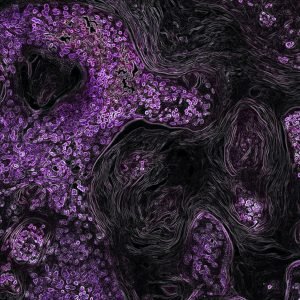Description
Package Size
50 tests/box, 100 tests/box
Intended Use
Used for antigen repair prior to immunohistochemical (IHC) staining.
Test Principle
As tissues are fixed in formaldehyde,paraformaldeh de or other aldehyde reagents, cross-linking between proteins and closure of the aldehyde group occurs, which masks the antigenic determinants and loses antigenicity,resulting in a weakened signal during IHC staining. When tissue cell antigens are placed in antigen repair buffer for heat treatment, the antigenic epitopes masked by fixation can be improved, and the cross-linked protein peptide chains can be opened to re expose the antigenic decision clusters without destroying the epitope structure, thus achieving the effect of enhancing specific expression and reducing the non-specific background, and decreasing the occurrence of false positives and false-negatives.
Main Components
| Product | Main Ingredients | 50tests/box | 100tests/box |
| IHC antigen repair buffer | Tris(hydroxymethyl) aminomethane, ethylenediaminetetraacetic acid | 8mL/bottle×3 | 15mL/bottle×3 |
Other materials required but not included: sample release reagent, immunochromogenic reagent, washing solution, bluing buffer, DAB staining enhancement solution, alcohol, tissue clearing agent, neutral gum, etc.
Storage and Stability
Store at 2-8 °C, valid for 12 months.
Production date: see label;
Expiration date: see label;
Applicable Instruments
Suitable for fully automated IHC staining machine PA-3600.
Specimen Collection and Preparation
Fresh biopsy or paraffin embedded tissue fixed in 10% neutral formalin. The thickness of the section should be within the range of 3-5 μm. Subsequent testing should be completed as soon as possible after preparation. and slides should not be stored at room temperature for more than 10 days.
Sample collection, fixation, embedding, and slide-making should comply with the requirements of the Pathology Technical Work Specifications.
Operations
This product is ready-to-use, pH 9.0.When used with fully automatic IHC staining machine PA-3600, the process from dewaxing to counterstaining is completed by it.
1. Bake the prepared slides at 60 °C for 1 hour;
2. Follow the operating instructions of the instrument software;
3. Use the instrument software to set up the program and print the label;
4. Load labeled slides into the instrument;
5. Put the reagents into the reagent rack, and confirm the reagent type is correct and the amount of reagent is sufficient to complete the experiment; Place the reagents into the reagent rack and confirm that the reagent type is correct and the amount of reagent is sufficient to complete the experiment;
6. Start running and perform automatic staining.
7. After staining is completed, remove the slide and rinse under running water.
8. Use gradient alcohol for dehydration and tissue transparent reagent for transparency.
9. Use neutral gum and coverslip for sealing, drying and deodorization.
For detailed information,please refer to the instruction manual of the fully automatic IHC staining machine PA-3600.
Quality control
1. Each serial of experiments should be set up with a positive quality control slide to monitor the operation process and the quality of reagents; a positive control tissue can be prepared and tested at the same time while processing the experiments, which is more effective to monitor and avoid false-negative staining.
2. Each serial of experiments should be set up with negative quality control reagent (blank control, antibody dilution) and negative quality control slides (the same as the positive control tissue) to monitor the background staining of the secondary antibody and to avoid false-positive staining.
3. In the case of normal staining of the above quality control slides, the interpretation of the sample slides is meaningful; if the staining situation is abnormal, it is necessary to find out the reason and re-experiment.
Interpretation of test results
Depending on the type of tissue being repaired. Analysis of results should be performed by a qualified pathologist.
Limitations of testing methods
1. The reagent is intended for use on fresh tissue and paraffin tissue sections only;
2. The test result is only used as an aid to provide doctors / physician with auxiliary information for diagnosis;
3. The preparation of sample slides includes a series of processes, which are affected by many pre-processing factors, such as sample material,fixation method, section thickness, etc.;
4. The clinical interpretation of any positive/negative result should be interpreted within the context of the clinical manifestations in conjunction with morphological and other histological criteria.
5. The selection of other general reagents during the experiment, the method and time of antigen retrieval, and the operator’s habits will all affect the final results;
Product Performance Indicators
Appearance:
The appearance of the packaging should be clean, no leakage, and no damage; the label should be clear and not worn; the reagent should be transparent and clear liquid.
Performance:
Positive compliance: Use the reagent to be tested to detect the positive reference slide. The positive control staining result should be positive, and the positive coloring should be positioned accurately, without background coloring and non-specific coloring. The positive compliance rate should be 100%.
Negative compliance: Use the reagent to be tested to detect the negative reference slide. The negative control staining result should be negative, the color of hematoxylin counterstaining should be clear, and the negative compliance rate should be 100%;
Compliance of blank control: Use blank control (antibody diluent) to detect the positive reference slide and negative reference slide. The blank control staining result should be negative, the hematoxylin counterstain color should be clear, and the blank control compliance rate should be 100%;
Intra-batch reproducibility: The intensity and localization of the staining of tissue slides from the same tissue source are not significantly different when tested on the reproducible reference slides.
Precautions:
1) This product is a single-use in vitro diagnostic reagent, please do not reuse it. Expired products cannot be used;
2) this product should be used by professionals;
3) Insufficient amount of reagent in the experiment may lead to erroneous results;
4) Excessive repair may lead to tissue debridement;
5) If you have any questions or suggestions while using this product, please contact local or manufacturer technical support.







